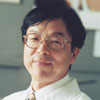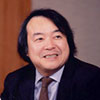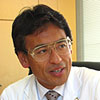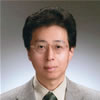
Minoru Ueda
Professor, Nagoya University Graduate School of Medicine
Professor,
Institute of Medical Science, University of Tokyo
 With the coming of the aging society, it is now evident that conventional medical techniques are not sufficient to cure diseases that tend to afflict the elderly. Illnesses that strike older populations are degenerative diseases caused by the aging and deterioration of cells. These diseases cannot be cured by medication. There is only one way to cure such diseases: cell replacement. Regenerative medicine provides a means of treating patients with illnesses that cannot be cured with any drug. In this sense, I believe that this new category of medicine will be a great boon to the aging society. With the coming of the aging society, it is now evident that conventional medical techniques are not sufficient to cure diseases that tend to afflict the elderly. Illnesses that strike older populations are degenerative diseases caused by the aging and deterioration of cells. These diseases cannot be cured by medication. There is only one way to cure such diseases: cell replacement. Regenerative medicine provides a means of treating patients with illnesses that cannot be cured with any drug. In this sense, I believe that this new category of medicine will be a great boon to the aging society.
Regenerative medicine will create a new epoch in medical technology. Not only does it cure illnesses that were thought to be incurable, it also cures them by regenerating the patients’ affected cells or body parts from their own cells. Treatment is based not on medication, transplants or artificial organs. That is why regenerative medicine is thought to have more fundamental effect than conventional medicine. I am convinced that this newly developed medical field will improve the health and quality of life of many people and help them lead happier lives.
To Professor Ueda’s lab >>
Shigeru Kinoshita
Professor, Department of Ophthalmology, Kyoto Prefectural University of Medicine
 Ocular surface reconstruction by regenerative medicine using corneal epithelial stem cells will be a surgical treatment of the next generation. The Department of Ophthalmology at Kyoto Prefectural University of Medicine has developed a new modality or regenerative medical treatment for patients bilaterally affected with severe ocular surface diseases. By culturing either homologous human corneal epithelial cells or autologous oral mucosal epithelial cells on amniotic membrane, an epithelial sheet is created and transplanted to the patient’s cornea. In a clinical study approved by our IRB, the clinical efficacy of this method has been confirmed in dozens of cases. Ocular surface reconstruction by regenerative medicine using corneal epithelial stem cells will be a surgical treatment of the next generation. The Department of Ophthalmology at Kyoto Prefectural University of Medicine has developed a new modality or regenerative medical treatment for patients bilaterally affected with severe ocular surface diseases. By culturing either homologous human corneal epithelial cells or autologous oral mucosal epithelial cells on amniotic membrane, an epithelial sheet is created and transplanted to the patient’s cornea. In a clinical study approved by our IRB, the clinical efficacy of this method has been confirmed in dozens of cases.
It is highly likely that the cultured corneal epithelial sheet contains numerous stem cells. I believe that ocular surface reconstruction by means of cultured corneal or mucosal epithelium will play a cutting-edge role in regenerative medicine.
Venture companies aiming to pursue regenerative medicine are currently engaged in developing treatment methods for intractable diseases; their business activities are attracting much public attention. ArBlast is one such company. It aims to make use of the technological spin-off from research on amniotic membranes taken from placentas for the purpose of advancing regenerative medicine.
As previously mentioned, our department is centering its research on regenerative medicine concerning ocular surface reconstruction. Because we have a scientific interest in the same areas as ArBlast, there are occasions on which we and the company share each other’s know-how. I am convinced that ArBlast will develop new basic technologies relating to regenerative medicine, providing breakthroughs in ophthalmology and contributing a great deal to the advancement of the medical technology of the 21st century.
To Professor Kinoshita’s lab >>
Kazuo Tsubota
Professor, Department of Ophthalmology, Keio University
 In recent years, we have witnessed dramatic progress in science and medical technology. The advancement of research and development in the field of regenerative medicine, among other areas, has been especially remarkable. At our facility, we have developed a regenerative medical technique to culture corneal stem cells on amniotic membrane for the purpose of transplantation. With this technique, we can now cure cases that were once incurable, and help patients restore their vision. In recent years, we have witnessed dramatic progress in science and medical technology. The advancement of research and development in the field of regenerative medicine, among other areas, has been especially remarkable. At our facility, we have developed a regenerative medical technique to culture corneal stem cells on amniotic membrane for the purpose of transplantation. With this technique, we can now cure cases that were once incurable, and help patients restore their vision.
As is well known, amniotic membrane has the mysterious ability of enabling the mother and the fetal baby to coexist without allowing the mother’s immune system to recognize the fetus as a foreign body. Because of its extraordinary characteristics, amniotic membrane is expected to play a significant role in regenerative medical treatment.
Meanwhile, much attention has been directed toward how to maintain a decent quality of life in an increasingly aging society. We ophthalmologists are engaged in research on regeneration of the cornea, retina and other eye structures, and eventually the entire eye. It is true that regenerative medicine faces various ethical, economic and other social challenges. The essential role of medicine and the central mission of doctors are to develop new treatments from the advancement of medical technology and make them safely and swiftly available to as many patients as possible. However, the provision of substantial medical care requires cooperation among doctors, companies, research institutes and their staff. It is my hope that ArBlast Co., Ltd. will continue its efforts to respond to the voices of patients and thereby make a genuine contribution to society.
To Professor Tsubota’s lab >>
Satoru Yamagami
Corneal Endothelium Regeneration Research Team, Foundation for Biomedical Research and Innovation
Department of Ophthalmology, Tokyo Women's Medial Unibersity Medical Center East
 Functioning as the window of the eye, the cornea must have transparency. Corneal endothelial cells, among other parts of the cornea, play the most important role in maintaining corneal transparency. Damage to corneal endothelial cells, therefore, leads to severe deterioration of eyesight, for which corneal transplant is the only treatment currently available. At present, more than half of corneal transplant patients undergo this surgery because of damaged corneal endothelial cells alone. Corneas for transplant, however, are in seriously short supply all over the world. Functioning as the window of the eye, the cornea must have transparency. Corneal endothelial cells, among other parts of the cornea, play the most important role in maintaining corneal transparency. Damage to corneal endothelial cells, therefore, leads to severe deterioration of eyesight, for which corneal transplant is the only treatment currently available. At present, more than half of corneal transplant patients undergo this surgery because of damaged corneal endothelial cells alone. Corneas for transplant, however, are in seriously short supply all over the world.
To overcome these challenges we have been striving to develop a regenerative medical approach designed to transplant corneal endothelial cells alone. As a result, we have succeeded in mass-culturing human corneal endothelial stem cells and in developing a treatment using these cells. Currently, we are improving these techniques for future clinical application.
To make such refined regenerative medical techniques available to as many patients as possible, however, we must have advanced technology for the manufacture of safe and consistent-quality regenerative medicine materials: this is where the medical community needs help from industry. That is why both patients and doctors wish to see companies specialized in regenerative medicine, such as ArBlast, produce regenerative medicine materials. With regenerative medicine drawing much attention as an innovative medical approach in recent years, it is our strong hope that ArBlast will lead the regenerative medicine industry by playing a substantial role in making regenerative medicine available to more people.
|